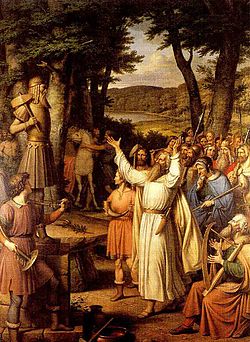Gothi

A depiction of a goði leading the people in sacrificing to Thor in this painting by J. L. Lund
A goði or gothi (plural goðar) is an Old Norse term for a chieftain-priest. Gyðja is the female form. The title is primarily known from medieval Iceland where it lived on as a secular political title after Christianization.
Contents
1 History
2 Etymology
3 Neopaganism
4 See also
5 References
6 Further reading
History
During the pagan era, the goði was a local chieftain who also served in the role of priest. After the Settlement in Iceland, the hofgoði was a temple priest; this was usually a wealthy and respected man in his district, for he had to maintain the communal hall or hof in which community religious observances and feasts were held. The area over which a goði had leadership was termed a goðorð. Over time, and especially after 1000, when the Christian conversion occurred in Iceland, the term goði lost its sacred connotations and came to mean simply "chieftain".
Etymology
The name appears in Wulfila's Gothic language translation of the Bible as gudja for "priest", but in Old Norse it is only the feminine form gyðja that perfectly corresponds to the Gothic form.[1] The corresponding masculine Old Norse form would have been an unattested *gyði.[1]
In Scandinavia there are surviving early attestations in the Proto-Norse form gudija from the Norwegian Nordhuglo runestone (Rundata N KJ65 U),[2] and in the later Old Norse form goði from two Danish runestones, the Glavendrup stone (DR 209) and the Helnæs Runestone (DR 190).[1] There are also a few placenames, such as Gudby in Södermanland, Sweden, that probably retain the name.[3]
Otherwise, there are no further surviving attestations except from Iceland where the goðar would be of historical significance.
Neopaganism
The term goði is often used as a priestly title by modern adherents of various denominations of Germanic Neopaganism.
See also
Althing, a plain in medieval Iceland where the goðar assemble to decide on legislation and dispense justice.
Allsherjargoði, a goði who sanctifies the Althing, or the chief religious official of the modern Ásatrúarfélagið organisation.
Blót, a sacrifice in Germanic Heathenry to the Norse gods, the spirits of the land, and the ancestors.- Sacred king
- Divine right of kings
- Imperial cult
References
^ abc An Icelandic-English dictionary by Richard Cleasby and Gudbrand Vigfusson (1874) p. 208.
^ The article gotiska in Nationalencyklopedin (1992)
^ Hellquist, Elof. (1966). Svensk etymologisk ordbok. C.W.K. Gleerups förlag, Lund. p. 308
Further reading
| Look up goði in Wiktionary, the free dictionary. |
- Aðalsteinsson, Jón Hnefill (1998). "Blót and Þing: The Function of the Tenth-Century Goði", in A Piece of Horse Liver: Myth, Ritual and Folklore in Old Icelandic Sources, 35–56. Reykjavik. .mw-parser-output cite.citationfont-style:inherit.mw-parser-output .citation qquotes:"""""""'""'".mw-parser-output .citation .cs1-lock-free abackground:url("//upload.wikimedia.org/wikipedia/commons/thumb/6/65/Lock-green.svg/9px-Lock-green.svg.png")no-repeat;background-position:right .1em center.mw-parser-output .citation .cs1-lock-limited a,.mw-parser-output .citation .cs1-lock-registration abackground:url("//upload.wikimedia.org/wikipedia/commons/thumb/d/d6/Lock-gray-alt-2.svg/9px-Lock-gray-alt-2.svg.png")no-repeat;background-position:right .1em center.mw-parser-output .citation .cs1-lock-subscription abackground:url("//upload.wikimedia.org/wikipedia/commons/thumb/a/aa/Lock-red-alt-2.svg/9px-Lock-red-alt-2.svg.png")no-repeat;background-position:right .1em center.mw-parser-output .cs1-subscription,.mw-parser-output .cs1-registrationcolor:#555.mw-parser-output .cs1-subscription span,.mw-parser-output .cs1-registration spanborder-bottom:1px dotted;cursor:help.mw-parser-output .cs1-ws-icon abackground:url("//upload.wikimedia.org/wikipedia/commons/thumb/4/4c/Wikisource-logo.svg/12px-Wikisource-logo.svg.png")no-repeat;background-position:right .1em center.mw-parser-output code.cs1-codecolor:inherit;background:inherit;border:inherit;padding:inherit.mw-parser-output .cs1-hidden-errordisplay:none;font-size:100%.mw-parser-output .cs1-visible-errorfont-size:100%.mw-parser-output .cs1-maintdisplay:none;color:#33aa33;margin-left:0.3em.mw-parser-output .cs1-subscription,.mw-parser-output .cs1-registration,.mw-parser-output .cs1-formatfont-size:95%.mw-parser-output .cs1-kern-left,.mw-parser-output .cs1-kern-wl-leftpadding-left:0.2em.mw-parser-output .cs1-kern-right,.mw-parser-output .cs1-kern-wl-rightpadding-right:0.2em
ISBN 9979-54-264-0. - Byock, Jesse L. (1993). "Goði". Entry in Medieval Scandinavia, an Encyclopedia (Phillip Pulsiano, ed.), 230–231. Garland: NY and London,
ISBN 0-8240-4787-7.
